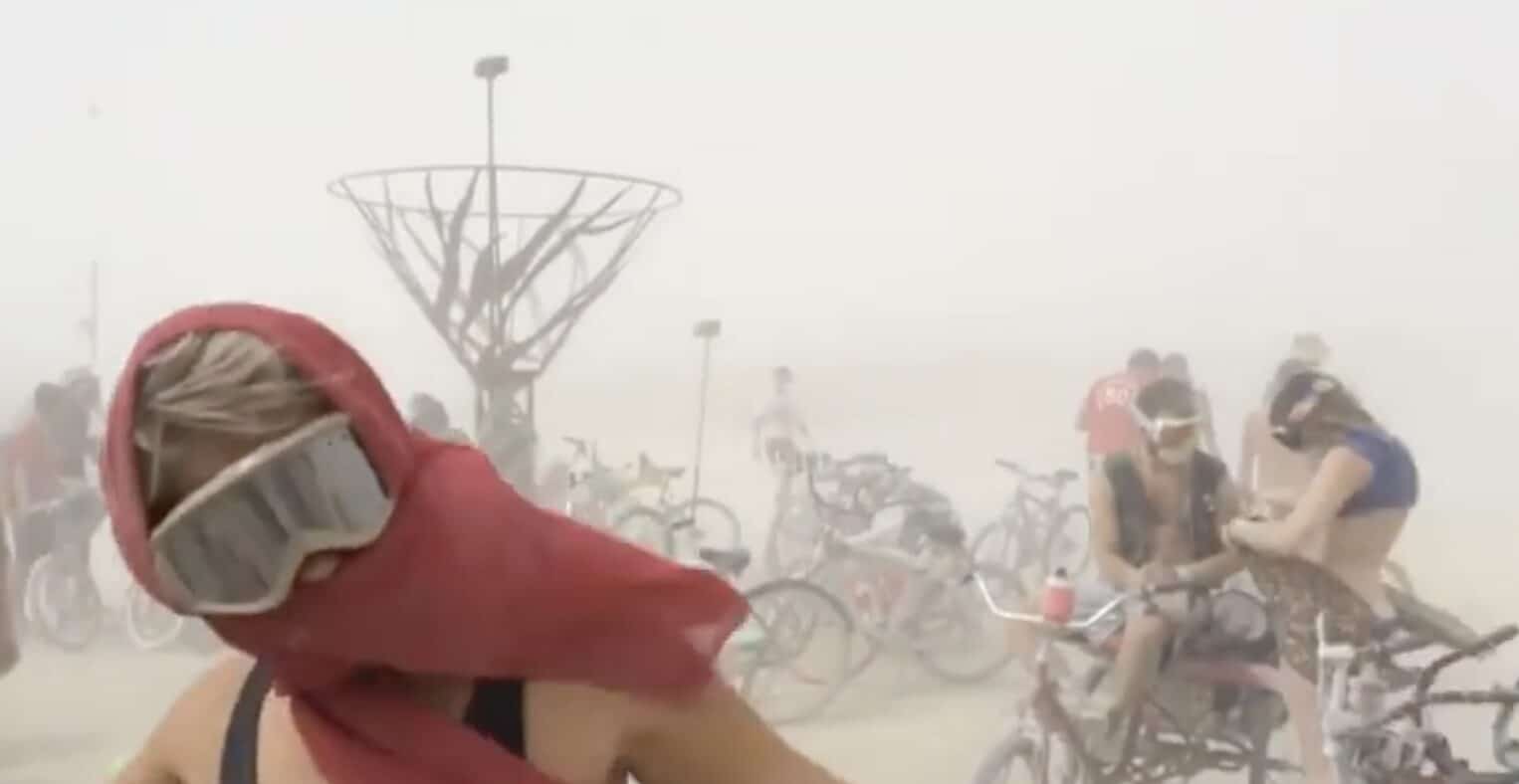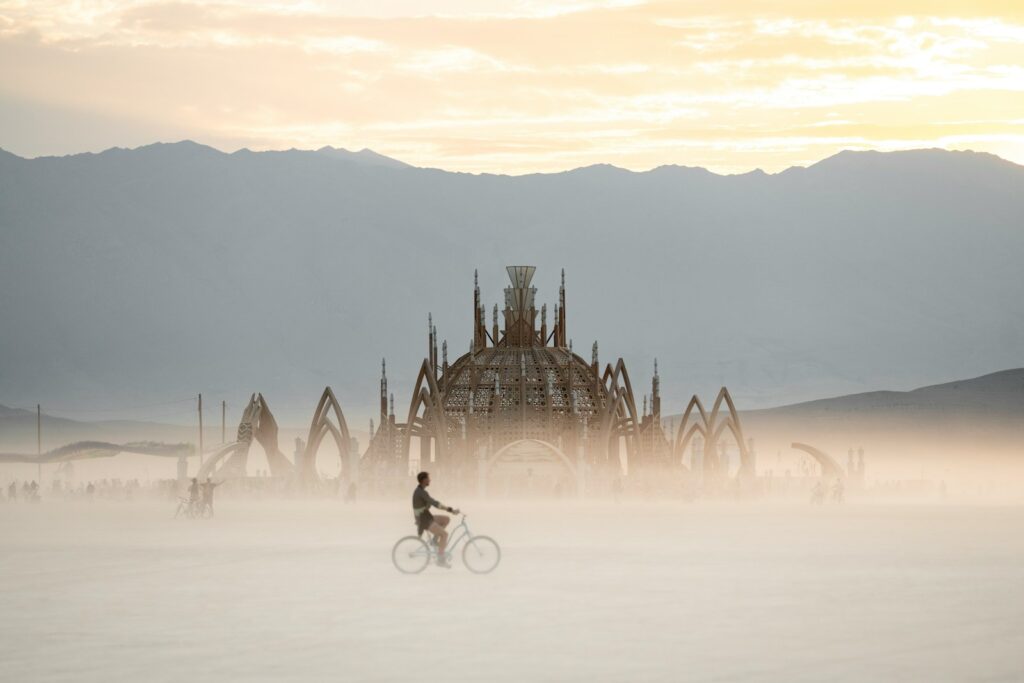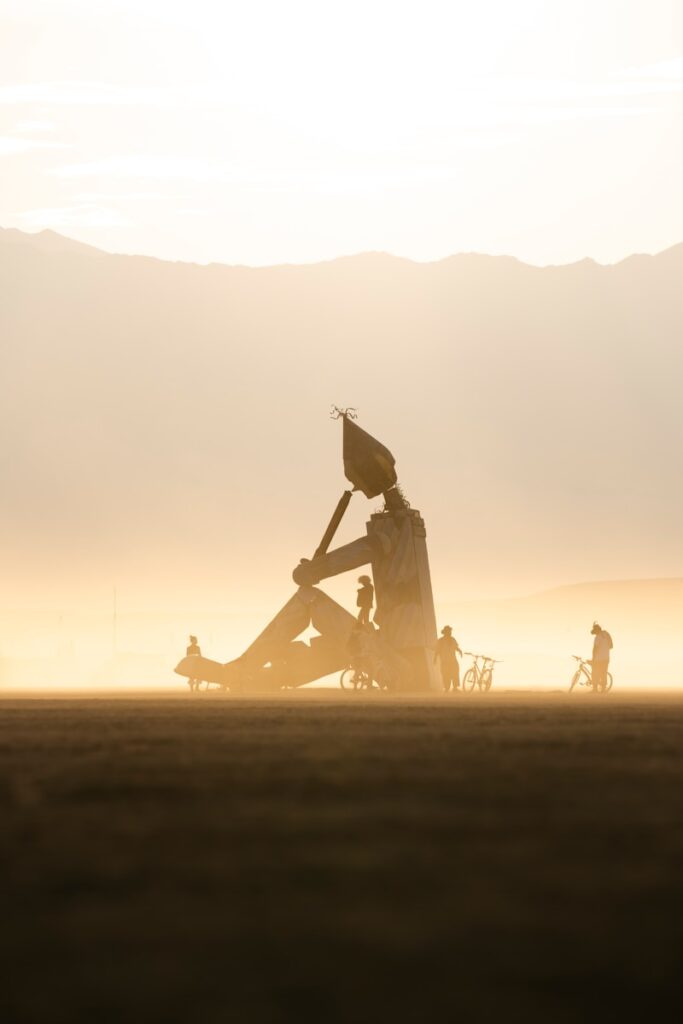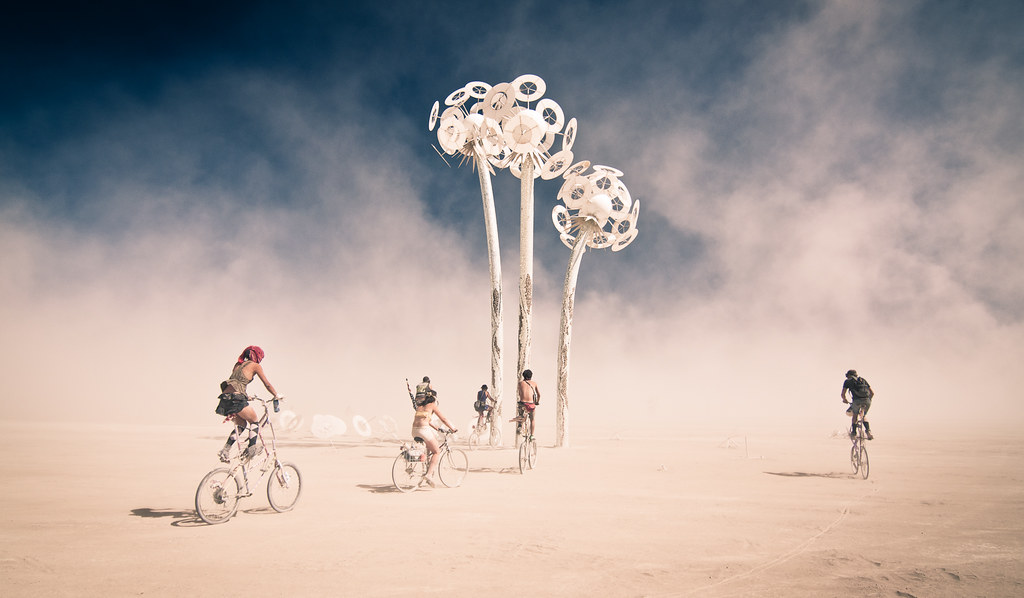Physical Address
304 North Cardinal St.
Dorchester Center, MA 02124
Physical Address
304 North Cardinal St.
Dorchester Center, MA 02124

Burning Man 2025 got off to a chaotic start as powerful dust storms with winds reaching 50 mph slammed into Black Rock City on the festival’s opening weekend. The extreme weather created dangerous conditions that forced organizers to temporarily close the entrance gates and left thousands of attendees trapped in traffic jams lasting up to 19 hours.
The apocalyptic conditions destroyed art installations, flipped portable toilets, and reduced visibility to just one foot as loose alkaline dust whipped across Nevada’s Black Rock Desert. Wind-whipped dust storms and slippery mud created massive traffic delays for the tens of thousands of “Burners” trying to reach the remote desert location.
Despite the harsh weather, 40,000 people had already made it onto the festival grounds by August 25. The dust storm flipped tents and installations while organizers warned of continued unstable weather conditions and potential flooding risks throughout the week-long event.

The dust storms that struck Burning Man on day one created dangerous conditions with near-zero visibility and forced thousands of festival-goers to seek shelter. These storms developed from specific weather patterns in Nevada’s Black Rock Desert and continued for hours.
Dust storms at Burning Man are intense weather events that occur when strong winds lift fine particles from the desert floor into the air. The Black Rock Desert in Nevada creates perfect conditions for these storms because of its dry lake bed surface and open terrain.
During these storms, visibility can drop to just a few feet. The fine alkaline dust gets into everything and can cause breathing problems for people without proper protection.
Sandstorms are powerful natural events that can blind entire regions and create dangerous conditions. At Burning Man, these storms are common because the festival takes place on an ancient lake bed.
The dust particles are extremely fine and light. They stay in the air for long periods even after winds die down. This creates a hazy, difficult environment that can last for hours.
Key characteristics include: Apocalyptic Sand Storms at Burning Man
The dust storm began building in the early afternoon on day one of the festival. Winds started picking up around 2 PM local time, with gusts reaching 40-50 mph.

By 4 PM, the storm was in full force. Burning Man festival-goers faced raging dust storms that created near-whiteout conditions across the entire event area.
The storm peaked between 5 PM and 7 PM. During this time, many attendees reported they could not see their own hands stretched out in front of them.
Storm Timeline:
The storm continued with varying intensity throughout the evening. Some areas experienced brief clearing periods before the dust returned.
High pressure systems and temperature differences created the perfect setup for the dust storm. Nevada’s desert climate in late August often produces these conditions.
The day started with clear skies and temperatures in the 80s. Atmospheric pressure began dropping around noon, indicating changing weather patterns.
Wind patterns shifted from light morning breezes to strong sustained winds by afternoon. The dry conditions and recent lack of rain made the desert floor extremely loose and easy to lift.
Temperature differences between the hot desert floor and cooler air above created unstable conditions. This instability helped fuel the strong winds that lifted massive amounts of dust.
Contributing factors:
A dust storm hits the Black Rock Desert in northwestern Nevada, creating dangerous visibility conditions. These weather patterns are typical for the region during late summer months.
The dust storm created immediate challenges across Black Rock City’s temporary infrastructure. Gate operations faced severe disruptions while camps struggled with limited visibility and safety concerns.

The dust storm reduced visibility to just five feet across the Black Rock Desert. This created dangerous conditions for the thousands of camps spread throughout Black Rock City.
Many participants had to secure their temporary structures against the powerful winds. Tents and shade structures faced damage from the storm’s intensity.
At least one major art piece was destroyed during the weather event. The storm also damaged other installations that artists had spent months preparing.
Camp activities came to a halt as people sought shelter. The festival’s collaborative spirit showed as staff and attendees worked together to help each other through the crisis.
Burning Man gates reopened after the storm but traffic problems continued for hours. The gate closure trapped people both entering and leaving the festival.
Long lines formed as vehicles moved very slowly through the desert. Festival-goers faced hours of delays while trying to reach the event’s edge.
The line of cars stretched all the way back into Black Rock City. Traffic moved at an extremely slow pace due to the poor visibility conditions.
The storm forced officials to suspend small aircraft operations in the area. Private planes and helicopters could not safely navigate the dust-filled air.
At least four people were injured during the storm event. Medical teams had difficulty reaching those who needed help due to the limited visibility.
Emergency services worked to ensure participant safety throughout the crisis. The festival’s medical infrastructure adapted to handle storm-related injuries and health concerns.
Officials advised all attendees to stay in their camps until conditions improved. This shelter-in-place approach helped prevent more serious accidents during the worst of the storm.
Government agencies and law enforcement moved quickly to address the dangerous conditions at Burning Man. The National Weather Service issued dust storm warnings while local authorities coordinated emergency responses for tens of thousands of attendees.
The National Weather Service tracked the developing weather conditions throughout the festival’s opening day. Meteorologists issued specific warnings about blowing playa dust that could impact festival operations.
Weather officials monitored wind patterns across Nevada’s Black Rock Desert. They predicted that winds could kick up dangerous amounts of dust during critical periods.
The agency used its standard alert system to communicate hazardous conditions. These warnings helped festival organizers prepare for the incoming storm system.
The Pershing County Sheriff’s Office coordinated emergency response efforts during the dust storm event. Local law enforcement worked with festival security to manage crowd control and safety protocols.
Officers positioned themselves at key locations throughout the festival grounds. They monitored high-traffic areas where visibility dropped to dangerous levels during the storm.
Emergency services responded to medical calls during the chaotic conditions. Officials handled reports of unresponsive individuals at 11:29 a.m. during the first day of the nine-day festival.
Festival organizers distributed safety advisories through multiple communication channels. They warned attendees about the approaching dust storm and provided specific protection guidelines.
Officials advised people to seek shelter in vehicles or sturdy structures. They recommended covering airways with masks or cloth to prevent dust inhalation.
Event coordinators delayed certain activities until conditions improved. The advisories included instructions for securing loose items that could become dangerous projectiles in high winds.
Communication systems worked to keep attendees informed about changing conditions. Regular updates helped people make informed decisions about their safety during the storm.
The dust storms created immediate safety hazards through drastically reduced visibility and forced festival-goers to seek emergency shelter. Infrastructure damage and supply shortages required extensive community-wide response efforts to maintain basic operations.
Dust storms hit the Black Rock Desert and caused extremely low visibility conditions across the festival grounds. Attendees could barely see a few feet in front of them during peak storm conditions.
The reduced visibility led to several types of minor injuries. People walked into tent stakes, guy-wires, and other camp equipment they couldn’t see. Some attendees tripped over obstacles or collided with bicycles and art installations.
Common injury types included:
Many camps had to implement emergency protocols. They used rope guides between tents and required buddy systems for any movement during the worst visibility periods. Some camps set up emergency medical stations with basic first aid supplies.
The dust created additional challenges for people with existing health conditions. Those with asthma or other breathing problems faced increased difficulty during the storms.
The storms forced thousands of attendees to take immediate shelter in whatever structures they could find. Many camps experienced damage to their temporary buildings and shade structures from the intense winds.
Infrastructure damage included:
Supply shortages became a major concern as the storms continued. Camps struggled to maintain adequate food and water supplies when normal distribution methods became impossible. Some groups had to ration their resources until conditions improved.
Generator failures created power outages across multiple camps. The dust clogged air filters and damaged electrical equipment. Many camps lost refrigeration for food and medical supplies during the outages.
Water became particularly scarce as dust contaminated open containers. Camps had to cover all water sources and implement strict conservation measures to ensure everyone had enough to drink.
Attendees leaving Burning Man faced intense conditions that required massive cleanup efforts across the festival site. Community groups organized repair teams to fix damaged infrastructure and help struggling camps.
Volunteer crews formed immediately after the storms passed. They focused on clearing debris, repairing essential shelter structures, and restoring power to critical areas like medical stations and communication centers.
Priority repair efforts included:
The cleanup required specialized techniques due to the fine dust that penetrated everything. Teams used compressed air to clean electronic equipment and had to completely replace many air filters and mechanical components.
Many camps pooled their resources to help neighbors who lost essential supplies. Food sharing networks expanded dramatically as groups with surplus helped those facing shortages. The community response demonstrated the festival’s principles of mutual aid during crisis conditions.
The immediate dust storm threat gives way to new meteorological challenges that could compound existing problems at the festival site. Rain and thunderstorm activity poses significant flooding risks across the flat desert terrain where thousands remain gathered.
Weather forecasters track multiple storm systems approaching the Black Rock Desert region through the weekend. Thunderstorm development becomes increasingly likely as atmospheric moisture builds over Nevada.
The combination of unstable air masses and afternoon heating creates prime conditions for severe weather. Lightning strikes pose additional safety risks to festival attendees spread across the open desert floor.
Key Storm Indicators:
Meteorologists warn that even brief thunderstorms can produce intense rainfall rates. The desert environment lacks vegetation to absorb sudden water influxes.
The Black Rock Desert’s unique geography transforms minor rainfall into major flooding concerns. The flat playa surface prevents water drainage, creating temporary lakes across the festival grounds.
Heavy clay soil becomes impassable when wet. Vehicle movement becomes impossible as the ground turns into slick, sticky mud that can trap cars and RVs for days.
Flood Risk Factors:
Past Burning Man events experienced similar weather patterns in 2014 and 2017. Those years saw thousands of attendees stranded for additional days until conditions improved.
Weather models show a 60% chance of thunderstorms through Tuesday, with the highest probability on Sunday afternoon. Rain totals could reach 0.25 to 0.75 inches across the region.
Event organizers coordinate with emergency services to position rescue equipment strategically. Medical teams prepare for increased injury reports related to slippery conditions and limited mobility.
Attendees receive advisories to secure camping equipment and prepare for potential evacuation orders. Food and water supplies become critical if departure delays extend beyond Monday.
Preparation Timeline:
Temperature drops to the mid-60s during storm passage could provide relief from heat but increase hypothermia risks for unprepared participants.
Burning Man takes place in Nevada’s remote Black Rock Desert, approximately 100 miles north of Reno. The festival’s isolated location creates unique challenges for access and logistics, with limited nearby infrastructure and harsh desert conditions.
The Black Rock Desert serves as home to the annual Burning Man festival, located in northwestern Nevada. This vast playa sits on the remnants of ancient Lake Lahontan, which disappeared around 9,000 years ago.
The desert floor consists of hard-packed alkaline dust that becomes extremely fine when disturbed. Wind speeds of just 15 mph can kick up dust and reduce visibility dramatically. The flat, exposed terrain offers no natural windbreaks or shelter.
Temperatures in late August and early September often exceed 100 degrees Fahrenheit during the day. The combination of extreme heat and frequent dust storms creates challenging conditions for the estimated 70,000 to 80,000 festival attendees.
The playa’s surface has a water-repelling crust that prevents rain absorption. When storms do occur, water sits on top rather than soaking into the ground, creating muddy conditions that can strand vehicles.
Gerlach, Nevada serves as the primary gateway town to Burning Man, located closest to the festival site. This small community becomes a crucial stop for attendees needing fuel, supplies, and services during the event.
The town of Empire also provides access services, though festival organizers have warned of fuel shortages there. Attendees often must plan fuel stops carefully due to limited gas station availability.
Access to the festival site relies on a single main road system. During exodus periods, this creates significant bottlenecks when weather conditions deteriorate.
The remote location means emergency services and supply deliveries face long travel distances. Medical facilities and law enforcement must be brought in specifically for the event due to the lack of nearby infrastructure.